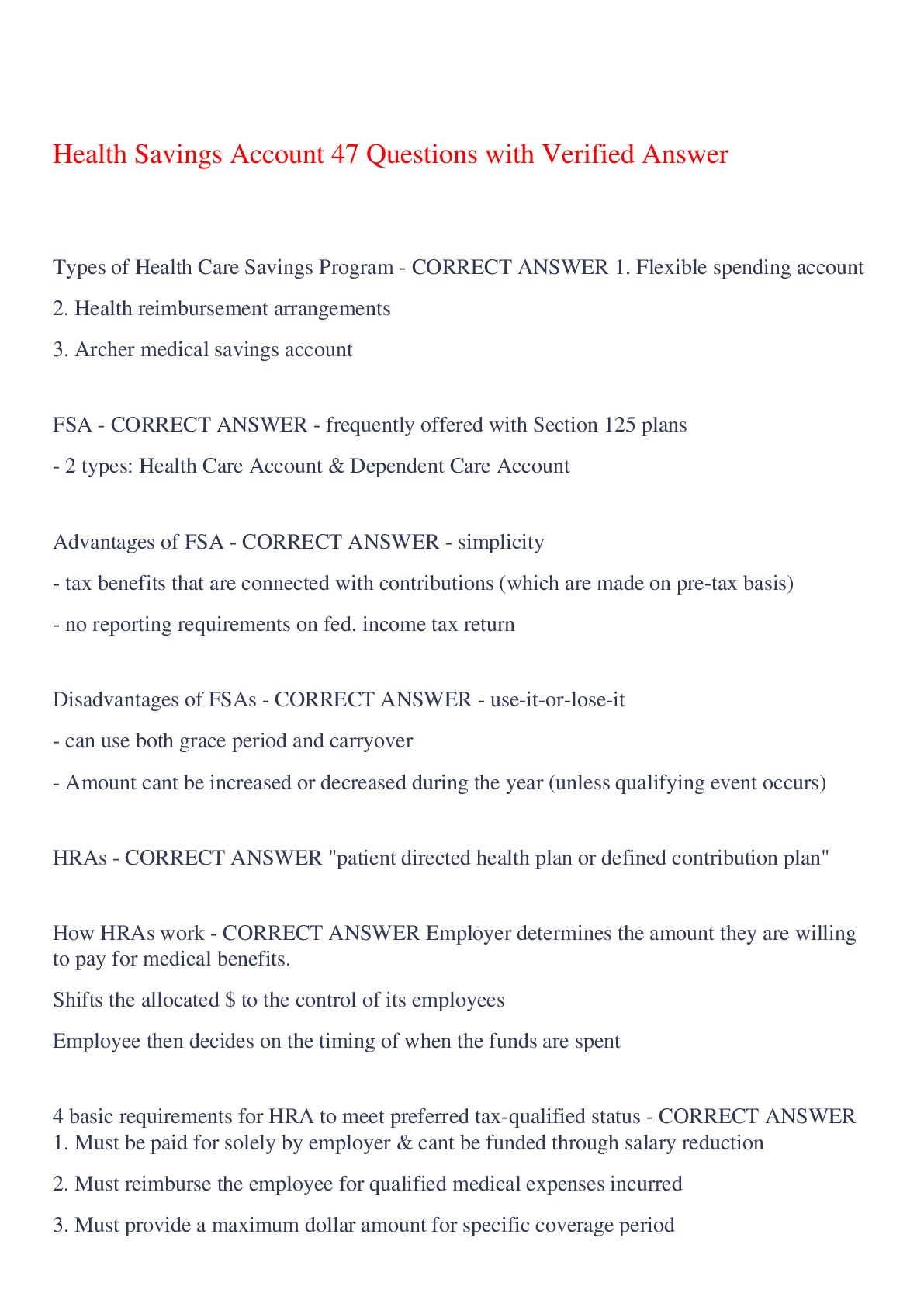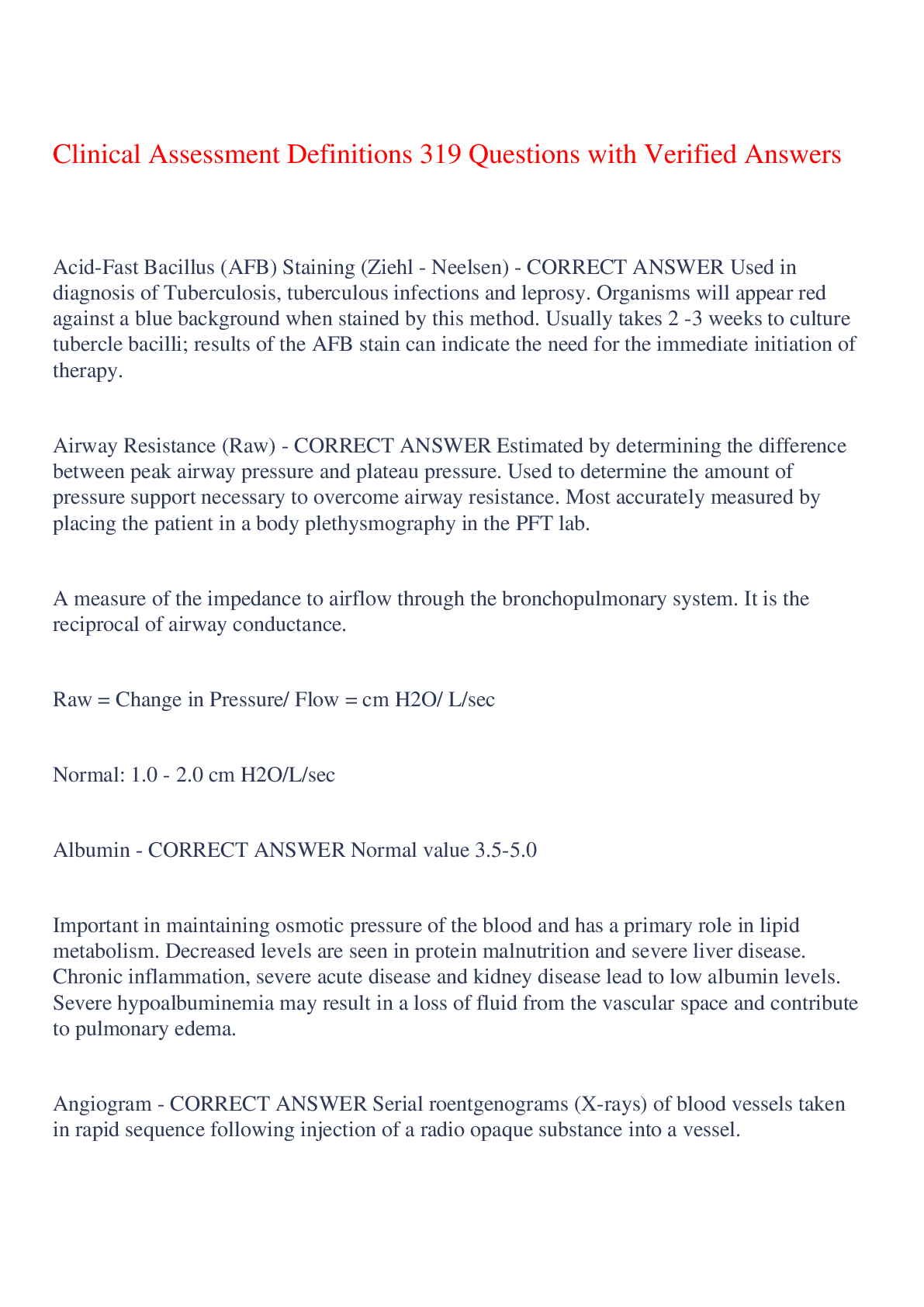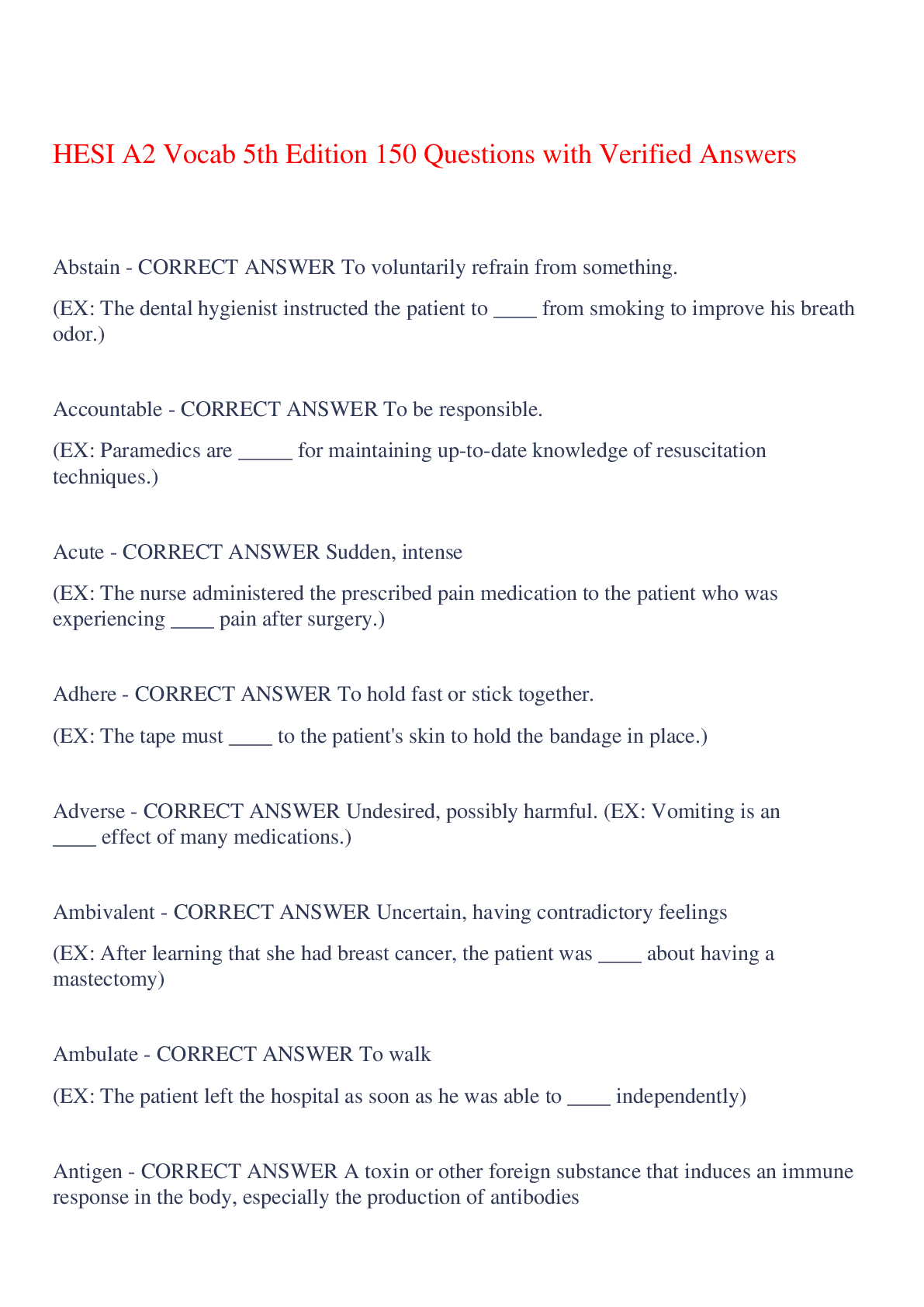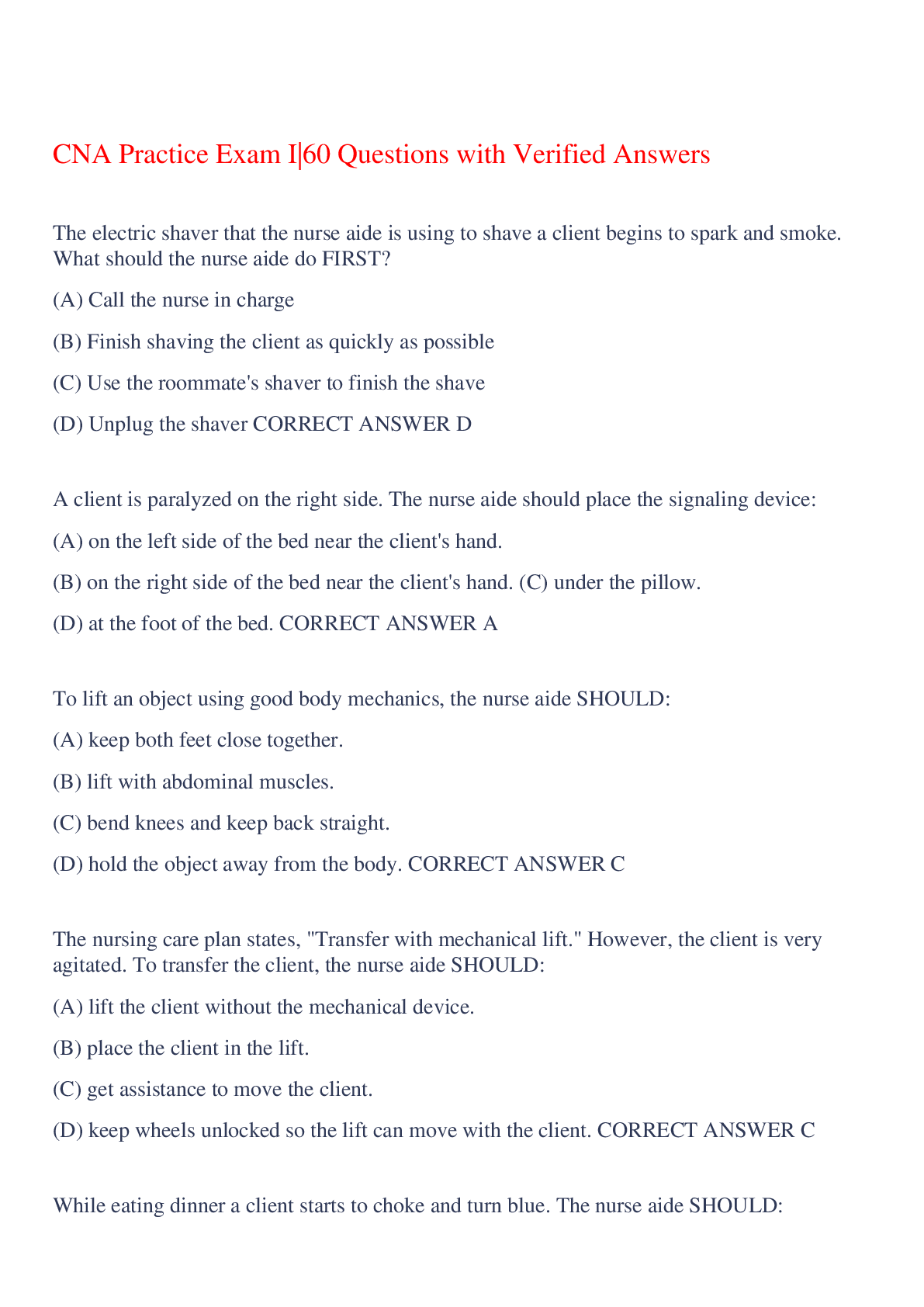EDF 6225 Exam 2|52 Questions with Verified Answers,100% CORRECT
Document Content and Description Below
EDF 6225 Exam 2|52 Questions with Verified Answers Chained Schedules - CORRECT ANSWER two or more schedules in the same order, can be for same or different behaviors and conditioned reinforcement f... or one element is the presentation of the next element. SD is present Multiple Schedules - CORRECT ANSWER Reinforcement occurs in an alternating, usually random sequence and can be identified by the SD. Concurrent Schedules - CORRECT ANSWER Reinforcement occurs when (a) 2 or more contingencies of reinforcement (b) operate independently and simultaneously (c) for 2 or more behaviors. Technological - CORRECT ANSWER the written description of all procedures used in the study is sufficiently complete and detailed to enable others to replicate it. Applied - CORRECT ANSWER investigates socially significant behaviors with immediate importance to the subject(s). Generality - CORRECT ANSWER produces behavior changes that last over time, appear in other environments, or spread to other behaviors. Determinism - CORRECT ANSWER The universe is a lawful and orderly place in which all phenomena occurs as the result of other events. Replication - CORRECT ANSWER repeating an experiment and producing the same results Parsimony - CORRECT ANSWER All simple explanations are ruled out before more complex or abstract explanations are considered. Philosophic Doubt - CORRECT ANSWER The continuous questioning of the truthfulness and validity of all scientific theory and knowledge Experimentation - CORRECT ANSWER the controlled comparison of some measure of the phenomenon of interest (the dependent variable) under two or more different conditions Empiricism - CORRECT ANSWER The objective observation of the phenomena of interest Conceptually Systematic - CORRECT ANSWER behavior change interventions are derived from basic principles of behavior Analytic - CORRECT ANSWER demonstrates experimental control over the occurrence and nonoccurrence of the behavior—that is, if a functional relation is demonstrated. Behavioral - CORRECT ANSWER actually measuring the behavior in need of improvement and document that it was the participants behavior that changed. Effective - CORRECT ANSWER improves behavior sufficiently to produce practical results for the participant/client. Abolishing Operations - CORRECT ANSWER weaken the effectiveness of a reinforcer or punisher. Premack Principle - CORRECT ANSWER reinforcing a target behavior by awarding some privilege to engage in a more desired behavior afterward "If/Then" Respondent Behavior - CORRECT ANSWER reflexive behavior; elicited by an antecedent motivating operations - CORRECT ANSWER An environmental variable that momentarily changes the value of a reinforcer or punisher and changes the probability of a behavior occurring. Makes you want or not want something. discriminative stimulus - CORRECT ANSWER signals the availability of reinforcement. Lets you know its available. Establishing operations - CORRECT ANSWER Make the reinforcer more powerful variable contingency - CORRECT ANSWER the response ratio or time requirements can change from one reinforced response to the next. Fixed contingency - CORRECT ANSWER the response ratio or time requirement remains the same. Evocative effect - CORRECT ANSWER behavior is more likely to occur Abative Effect - CORRECT ANSWER decreases probability of behavior that has led to accessing that reinforcer or punisher in the past. Automatic reinforcement - CORRECT ANSWER occurs when a persons behavior creates a favorable outcome without the involvement of another person. Limited Hold - CORRECT ANSWER following the end of the interval the individual has a set time to engage in target behavior before the next interval begins. Post-Reinfrocement Pause - CORRECT ANSWER present on fixed schedules of reinforcement due to the predictability of the schedule the individual may stop responding following reinforcement resuming based on time or value of reinforcement. Stimulus delta - CORRECT ANSWER a stimulus in the environment that signals the non-availability of reinforcement. Stimulus Control - CORRECT ANSWER when an organism behaves in one way in the presence of a given stimulus and another way in its absence Fixed ratio - CORRECT ANSWER Specific number of responses. Fixed interval - CORRECT ANSWER fixed amount of time variable ratio - CORRECT ANSWER variable number of responses Conditioned Punisher - CORRECT ANSWER A previously neutral stimulus change that functions as a punisher because of prior pairing with one or more other punishers. Matching Law - CORRECT ANSWER When different schedules of reinforcement are available at the same time for different behaviors, individuals will distribute their behavior according to the relative rates of reinforcement available for each option. Dependent Variable - CORRECT ANSWER the measured behavior in an experiment Independent Variable - CORRECT ANSWER the variable that is manipulated in an experiment unconditioned punisher - CORRECT ANSWER Punishment that works without prior learning (in other words, living things come into the world with a need to avoid these things "built in" to their biology). unconditioned reinforcer - CORRECT ANSWER reinforcers that do not need to be learned such as food, water, oxygen, warmth, and sex. Conditioned Reinforcer - CORRECT ANSWER something that needs to be learned through pairings with unconditioned reinforcers Punishment - CORRECT ANSWER Operant conditioner consists of a decrease in the response frequency. reinforcement - CORRECT ANSWER operant conditioner consists of an increase in the response frequency Positive Punishment - CORRECT ANSWER something is added after the behavior occurs and the behavior decreases. Negative Punishement - CORRECT ANSWER something is removed as a consequence and the behavior decreases. negative reinforcement - CORRECT ANSWER removal of a stimulus increases the future frequency of a behavior positive reinforcement - CORRECT ANSWER addition of a stimulus increases the future frequency of a behavior. Sidman (1993) - CORRECT ANSWER Escape, Avoidance Neef (1994) - CORRECT ANSWER Assessing Influential Dimensions of Reinforcers Osborne (1969) - CORRECT ANSWER Free time as a reinforcer Hernstien - CORRECT ANSWER Matching Law S-R Psychology - CORRECT ANSWER stimulus-response psychology [Show More]
Last updated: 4 months ago
Preview 1 out of 5 pages

Reviews( 0 )
Document information
Connected school, study & course
About the document
Uploaded On
Dec 25, 2023
Number of pages
5
Written in
Additional information
This document has been written for:
Uploaded
Dec 25, 2023
Downloads
0
Views
38



































